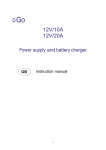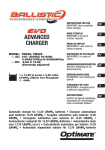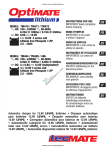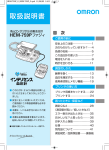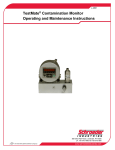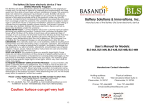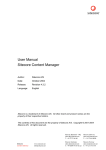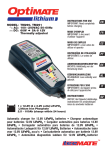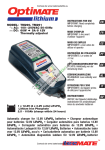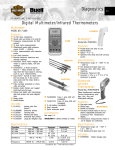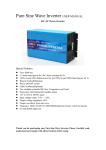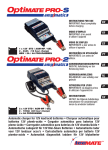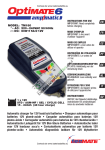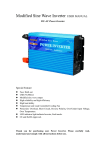Download Instructions - Moto
Transcript
MODEL: TM181 AC: 100 – 240VAC 50-60Hz DC: 60W ¨ 5A @ 12V Thermally adjusted INSTRUCTIONS FOR USE IMPORTANT: Read completely before charging MODE D’EMPLOI IMPORTANT: à lire avant d’utiliser l’appareil MODO DE EMPLEO IMPORTANTE: a leer antes de utilizar el aparato INSTRUÇÕES DE UTILIZAÇÃO IMPORTANTE: Ler antes de utilizar. SAE + - 1 x 12V STD / AGM-MF / GEL / CYCLIC CELL 15 - 240Ah (48 hour charge) Automatic charger for 12V lead/acid batteries • Chargeur automatique pour batteries 12V plomb-acide • Cargador automático para baterías 12V plomo-ácido • Carregador automático para baterias de 12V chumbo/ácido MOUNTING NOTICE NOTICE DE MONTAGE NOTA PARA EL MONTAJE NOTA DA MONTAGEM Max size: #8 / 4mm Min Length: 1” / 25mm 4x 6ft 6ft Extend with SAE-73 (15ft) SAE-73WP IMPORTANT SAFETY INSTRUCTIONS THIS PORTION OF THE MANUAL CONTAINS IMPORTANT SAFETY INSTRUCTIONS FOR THE OPTIMATE 6 BATTERY CHARGER. IT IS OF THE UTMOST IMPORTANCE THAT EACH TIME, BEFORE USING THE CHARGER, YOU READ AND EXACTLY FOLLOW THESE INSTRUCTIONS. SAVE THESE INSTRUCTIONS. AUTOMATIC CHARGER FOR 12V LEAD-ACID BATTERIES DO NOT USE FOR NiCd, NiMH, Li-Ion OR NON-RECHARGEABLE BATTERIES. 1. CAUTION : CLASS II APPLIANCE. DO NOT CONNECT TO GROUND. 2. For indoor use only. Do not expose charger to rain or snow. 3. Use of an attachment not recommended or sold by the battery charger manufacturer may result in a risk of fire, electric shock,or injury to persons. 4. To reduce risk of damage to electric plug and cord,pull by plug rather than cord when disconnecting charger. 5. An extension cord should not be used unless absolutely necessary. Use of improper extension cord could result in a risk of fire and electric shock.If extension cord must be used make sure that : a) pins on plug of extension cord are the same number, size and shape as those of plug on charger. b) the extension cord is property wired and in good electrical condition,and c) the conductor wire size is large enough for the AC ampere rating of the charger as specified in the table below. AC INPUT RATING IN AMPERES Equal to or greater than But less than 2A 3A LENGTH OF CORD, FEET (m) AWG SIZE OF CORD 25 (17.6) 50 (15.2) 100 (30.5) 18 18 14 6. Do not operate charger with damaged cord or plug - replace the cord or plug immediately. 7. Do not operate charger if it has received a sharp blow, been dropped,or otherwise damaged in any way; take it to a qualified serviceman. 8. Do not disassemble charger; take it to a qualified serviceman when service or repair is required. Incorrect reassembly may result in a risk of electric shock or fire. 9. To reduce risk of electric shock, unplug the charger from outlet before attempting any maintenance or cleaning. Turning off controls will not reduce this risk.Clean only with slightly moist,not wet, cloth.Do not use solvents. 10. WARNING - RISK OF EXPLOSIVE GASES. a) WORKING IN VICINITY OF A LEAD-ACID BATTERY IS DANGEROUS. B ATTERIES GENERATE EXPLOSIVE GASES DURING NORMAL BATTERY OPERATION. FOR THIS REASON, IT IS OF UTMOST IMPORTANCE THAT YOU FOLLOW THE INSTRUCTIONS EACH TIME YOU USE THE CHARGER. b) To reduce risk of battery explosion,follow these instructions and those published by the battery manufacturer and manufacturer of any equipment you intend to use in vicinity of the battery. Review cautionary marking on these products and on engine. 11. PERSONAL PRECAUTIONS. a) Someone should be within range of your voice OR close enough to come to your aid when you work near a lead-acid battery. b) Have plenty of fresh water and soap nearby in case battery acid contacts skin, clothing or eyes. c) Wear complete eye protection and clothing protection. Avoid touching eyes while working near battery. d) If battery acid contacts or enters eye, flood eye with cold running water for at least 10 minutes and get medical attention immediately. If battery acid contacts skin or clothing, wash immediately with soap & water. If acid enters an eye , immediately flood eye with running cold water for at least 10 minutes & get medical attention immediately. e) NEVER smoke or allow a spark or flame in vicinity of battery or engine. f) Be extra cautious to reduce risk of dropping a metal tool onto battery. It might spark or short-circuit battery or other electrical part that may cause explosion. g) Remove personal metal items such as rings, bracelets ,necklaces , and watches when working with a lead-acid battery. A lead-acid battery can produce a short-circuit current high enough to weld a ring or the like to metal, causing a severe burn. i) NEVER charge a frozen battery. 3 12. PREPARING TO CHARGE a) If necessary to remove battery from vehicle to charge,always remove grounded terminal from battery first. Make sure all accessories in the vehicle are off, so as not to cause an arc. b) Be sure area around battery is well ventilated while battery is being charged. Gas can be forcefully blown away by using a piece of cardboard or other non-metallic material as a fan. c) Clean battery terminals.Be careful to keep corrosion from coming in contact with eyes. d) Add distilled water in each cell until battery acid reaches level specified by battery manufacturer. This helps purge excessive gas from cells. Do not overfill. For a battery without cell caps, such as valve regulated lead acid (VRLA) or absorbed glass mat (AGM) batteries, carefully follow manufacturer’s recharging instructions. e) Study all battery manufacturer’s specific precautions such as removing or not removing cell caps while charging and recommended rates of charge. f) Determine voltage of battery by referring to vehicle or other user’s manual and BEFORE MAKING THE BATTERY CONNECTIONS , MAKE SURE TH AT THE VOLTAGE OF THE BATTERY YOU ARE GOING TO CHARGE MATCHES THE OUTPUT VOLTAGE OF THE CHARGER. 13. CHARGER LOCATION. a) Locate charger as far away from battery as DC cables permit. b) Never place charger directly above batterv being charged; gases from battery will corrode and damage the charger. c) Never allow battery acid to drip on charger when reading gravity or filling battery. Do not operate charger in a closed-in area or restrict ventilation in any way. d) Do not set a battery on top of charger. IMPORTANT : Place charger on a hard flat surface or mount onto a vertical surface. Do not place on plastic, leather or textile surface. 14. DC CONNECTION PRECAUTIONS a) Connect and disconnect DC output clips only after setting any charger switches to off position and removing AC cord from electric outlet. Never allow clips to touch each other, however should this happen no damage will result to the charger circuit & the automatic charging programme will just reset to «start». b) Attach clips to battery and chassis as indicated in 15(e), 15(f), and 16(b) through 16(d). NOTE : This battery charger has an automatic safety feature that will prevent it from operating if the battery has been inversely connected. Set charger switches to off position and/or remove AC cord from electrical outlet, disconnect the battery clips, then reconnect correctly according to the instructions below. 15. FOLLOW THESE STEPS WHEN BATTERY IS INSTALLED IN VEHICLE. A SPARK NEAR A BATTERY MAY CAUSE BATTERY EXPLOSION. TO REDUCE RISK OF A SPARK NEAR BATTERY : a) Position AC and DC cords so as to reduce risk of damage by hood, door or moving engine part. b) Stay clear of fan -blades, belts,pulleys,and other parts that can cause injury to persons. c) Check polarity of battery posts.POSITIVE (POS, P, +) battery post usually has larger diameter than NEGATIVE (NEG, N,–) post. d) Determine which post of battery is grounded (connected) to the chassis. If negative post is grounded to chassis (as in most vehicles),see (e). If positive post is grounded to the chassis,see (f). e) For negative-grounded vehicle, connect POSITIVE (RED) clip from battery charger to POSITIVE (POS, P, + ) ungrounded post of battery. Connect NEGATIVE (BLACK) clip to vehicle chassis or engine block away from battery. Do not connect clip to carburetor, fuel lines, or sheet-metal body parts. Connect to a heavy gage metal part of the frame or engine block. f) For positive-grounded vehicle, connect NEGATIVE (BLACK) clip from battery charger to NEGATIVE (NEG. N , -) ungrounded post of battery. Connect POSITIVE (RED) clip to vehicle chassis or engine block away from battery. Do not connect clip to carburetor, fuel lines, or sheet-metal body parts. Connect to a heavy gage metal part of the frame or engine block. g) When disconnecting charger, turn switches to off, disconnect AC cord,remove clip from vehicle chassis,and then remove clip from battery terminal. h) See operating instructions for length of charge information. 16. FOLLOW THESE STEPS WHEN BATTERY IS OUTSIDE VEHICLE. A SPARK NEAR THE BATTERY MAY CAUSE BATTERY EXPLOSION. TO REDUCE RISK OF A SPARK NEAR BATTERY : a) Check polarity of battery posts. POSITIVE (POS, P, +) battery post usually has a larger diameter than NEGATIVE (NEG,N, -) post. b) This battery charger has an automatic safety feature that will prevent it from operating if the battery has been inversely connected. The charger does allow charge current unless a voltage of at least 2V is sensed. c) Connect POSITIVE (RED) charger clip to POSITIVE (POS, P, +) post of battery. d) Connect NEGATIVE (BLACK) charger clip to NEGATIVE (NEG, N, -) battery post of the battery. e) Do not face battery when making final connection. f) When disconnecting charger, always do so in reverse sequence of connecting procedure & break first connection while as far away from battery as practical. g) A marine (boat) battery must be removed & charged on shore. To charge it on board requires equipment specially designed for marine use. 4 AUTOMATIC DIAGNOSTIC CHARGER FOR 12V LEAD-ACID BATTERIES FROM 15Ah TO 240Ah, AS FOUND IN: DO NOT USE FOR NiCd, NiMH, Li-Ion OR NON-RECHARGEABLE BATTERIES. Charge rate: 5 Ah / hour, will recharge a 240Ah battery in 48 hours. Input: 100-240V maximum 1,5A. The maximum output current is automatically adjusted according to the characteristics of the connected battery, in the range of 0,4A to 5A, by the ampmatic™ output control circuit (see §4.1 below). SAFETY WARNING AND NOTES: IF YOU HAVE NOT YET DONE SO, READ THE PRECEDING PAGES LABELLED "IMPORTANT SAFETY INSTRUCTIONS" BEFORE OPERATING THIS CHARGER. IMPORTANT: READ THE FOLLOWING INSTRUCTIONS BEFORE USING THE CHARGER This appliance is not intended for use by persons (including children) with reduced physical, sensory or mental capabilities, or lack of experience and knowledge, unless they have been given supervision or instruction concerning use of the appliance by a person responsible for their safety. Children should be supervised to ensure that they do not play with the appliance. IMPORTANT : Protect your charger from acid and acid fumes and from damp and humid conditions both during use and in storage. Damage resulting from corrosion, oxidation or internal electrical short-circuiting is not covered by warranty. Distance the charger from the battery during charging to avoid contamination by or exposure to acid or acidic vapours. If using it in the horizontal orientation, place the charger on a hard, flat surface, but NOT on plastic, textile or leather. Use the fixing holes provided in the enclosure base to attach the charger to any convenient, sound vertical surface. EXPOSURE TO LIQUIDS: This charger is designed to withstand exposure to liquids accidentally spilled or splashed onto the casing from above, or to light rainfall. Prolonged exposure to falling rain is inadvisable and longer service life will be obtained by minimizing such exposure. Failure of the charger due to oxidation resulting from the eventual penetration of liquid into the electronic components, connectors or plugs, is not covered by warranty. BATTERY CONNECTIONS: 2 interchangeable connection sets are available, supplied with the charger is a set of battery clips for charging the battery off-vehicle, the other connection set comes with metal eyelet lugs for permanent connection to the battery posts, and re-sealable weatherproof cap on the connector that connects to the charger output cable. This connection set allows easy and sure connection of the charger to maintain the battery on-vehicle. The resealable weatherproof cap is designed to protect the connector from dirt and damp whenever the charger is not attached. Consult a professional service agent for assistance in attaching the metal eyelets to the battery posts. Secure the connector with weatherproof cap so that it cannot foul any moving part of the vehicle or the cable can be pinched or damaged by sharp edges. The in-line fuse in the eyelets connection set protects the battery against such accidental shorting across positive and negative conductors. Replace any burnt fuse only with a similar new fuse of 15A rating. CONNECTING THE CHARGER TO THE BATTERY 1. Disconnect AC power supply before making or breaking DC / battery connections. 2. If charging a battery in the vehicle with the battery clips, before making connections, first check that the battery clips can be safely and securely positioned clear from surrounding wiring, metal tubing or the chassis. Make connections in the following order: First connect to the battery terminal not connected to the chassis (normally positive), then connect the other battery clip (normally negative) to the chassis well away from the battery and fuel line. Always disconnect in reverse sequence. 3. When charging a battery out of the vehicle with the battery clips, place it in a well ventilated area. Connect the charger to the battery: RED clamp to POSITIVE (POS, P or +) terminal and BLACK clamp to NEGATIVE (NEG, N or –) terminal. Make sure the connections are firm and secure. Good contact is important. 4. If the battery is deeply discharged (and possibly sulfated), remove from the vehicle and inspect the battery before connecting the charger for a recovery attempt. Visually check the battery for mechanical defects such as a bulging or cracked casing, or signs of electrolyte leakage. If the battery has filler caps and the plates within the cells can be seen from the outside, examine the battery carefully to try to determine if any cells seem different to the others (for example, with white matter between the plates, plates touching). If mechanical defects are apparent do not attempt to charge the battery, have the battery professionally assessed. 5. If the battery is new, before connecting the charger read the battery manufacturer’s safety and operational instructions carefully. If applicable, carefully and exactly follow acid filling instructions. 5 USING THE OPTIMATE 6: PROCEEDING TO CHARGE For safety reasons, the OptiMate output will only activate if a battery retaining at least 2V is connected, whereupon the micro processor instantly diagnoses the battery condition and engages the appropriate charge mode and lights the corresponding charge status LED. The charger’s special recovery mode cannot engage if it senses that the battery is still connected to a vehicle wiring circuit which effectively offers a lower electrical resistance than the battery on its own. However, if the deep-discharged battery is not removed for recovery, neither battery nor vehicle electronics will be damaged. VERY FLAT NEGLECTED BATTERIES: Pay particularly close attention to the following which is especially important for relatively small batteries such as those used on motorcycles, lawn tractors, jet-ski’s, snowmobiles and similar: A battery left deep-discharged for an extended period may develop permanent damage in one or more cells. Such batteries may heat up excessively during high current charging. Monitor the battery temperature during the first hour, then hourly there-after. Check for unusual signs, such as bubbling or leaking electrolyte, heightened activity in one cell compared to others, or hissing sounds. If at any time the battery is uncomfortably hot to touch or you notice any unusual signs, DISCONNECT THE CHARGER IMMEDIATELY. ECO POWER SAVING MODE WHEN THE CHARGER IS CONNECTED TO AC SUPPLY: To reduce long term power consumption OptiMate 6 employs two converter circuits, a power converter to charge the battery and an auxiliary converter to power the control circuitry and LED display. The power converter is switched off when the charger is not connected to a battery resulting in a very low power draw of less than 1,7W, equivalent to power consumption of 0,042 kWh per day. When a battery is connected to the charger power consumption depends on the current demand of the battery and its connected vehicle / electronic circuitry. After the battery has been charged and the charger is in long term maintenance charge mode (to keep the battery at 100% charge) the total power consumption is estimated to be 0,060 kWh or less per day. The LED indicators referred to below, and the clauses dealing with them, are sequenced as they may come on through the course of the program. LEDs #1 & 2 1 5 7 6 2 LEDs #5, 6 & 7 LED #10 LED #9 ampmatic AMPS LED #8 3 4 TURBO FINAL LEDs #3 & 4 1 and 2. INVERSE connections and input power 1. Connect the charger to a mains supply socket providing AC supply of 100 to 240V. The “POWER ON” LED #1 should illuminate and LEDs #3,4,5,6,7 should blink twice to confirm micro processor health. HIGH and LOW intensity indication: The "POWER ON" LED #1 will reduce intensity to a low level to indicate low power "ECO" mode. This will occur if there is no battery connected, or when a battery is connected and the program finds itself in the Initial and Extended voltage retention test mode or the 'rest' periods of Maintenance Charge mode. The "POWER ON" LED #1 will indicate brightly during Recovery charge, Bulk and Pulsed absorption charge and Maintenance charge modes. 2. If the INVERSE POLARITY LED #2 indicates, the battery connections are incorrect. The charger is electronically protected so no damage will result, and the output will remain disabled until the connections are corrected. 3. Recovery charge If the battery is extremely flat (deep-discharged and sulfated), the recovery mode will engage and the DESULFATE LED #3 will light. A special high voltage is applied to force a very small fixed current into the battery in a recovery attempt that may last for a maximum of two hours. Initially the voltage is limited to about 16V for 5 seconds while the circuit assesses whether this level is sufficient to recover the battery. 3.1 If the assessment is positive the voltage remains limited at 16V and the DESULFATE LED #3 remains on. 3.2 If the assessment is negative, typically for a badly neglected battery that has not received any charge for many months, the second more powerful TURBO stage will engage with the voltage limit reset to 22V. TURBO RECOVERY mode is indicated by a flashing DESULFATE LED #3. 3.3 Once the battery accepts the very low set current (0,4A LED #8 indicating) the voltage will reduce until the moment 6 when the automatic circuit judges that the battery can accept the final stage of the recovery programme. If the DESULFATE LED #3 was flashing during the TURBO mode (§3.2), it will now revert to steady indication. During 15 minutes the ampmatic™ current control will now deliver current in pulses (as displayed by LEDs #8, 9 and 10) whilst maintaining the voltage below 14,3V, to further prepare the battery to accept normal charge. This mode is particularly effective for initiating recovery of factory activated / “hi performance” pure lead or cyclic cell AGM batteries. NOTE: If the battery remains connected to the vehicle electrical system (even with ignition key in off position) the TURBO recovery stage cannot engage. 4. Bulk and pulsed absorption charge The BULK CHARGE stage (steady LED #4) will engage if the micro processor determines that the battery can accept charge at normal voltages levels. 4.1 The ampmatic™ charge current monitoring and control mode automatically determines the most efficient rate of charge current for the connected battery, according to its state of charge, state of health, and electrical storage capacity. The delivered current may be anywhere from 0,4A to 5A. For most discharged (but not totally flat) batteries of rated capacity 12Ah or more, CURRENT LED #10 should also light up. 4.2 The PULSED ABSORPTION stage (flashing CHARGE LED #4) starts when the voltage has reached 14,3V for the first time during BULK CHARGE stage. The ampmatic™ current control circuit now delivers pulses of current for 10 minutes so as to cause the battery voltage to vary between 13,7V and 14,3V, to equalise the individual cells within the battery and bring it to full charge as rapidly as possible. Charge current LED #8 and possibly #9 (ampmatic™) and #10 (5A) will light when current is delivered. 4.3 CHARGE VERIFICATION (flashing LED #4) follows PULSED ABSORPTION. The charging voltage is now limited at 13,6V during 5 minutes whilst the battery’s charge level is verified. If the battery requires further charging (indicated by the 0,4A charge current LED pulsing strongly) the programme will revert to the PULSED ABSORPTION stage (§ 4.2). These reversions may occur as many times as is necessary to reduce the battery’s current demand below 400mA at 13,6V (which is consistent with a battery that has accepted as much charge as its basic condition allows). As soon as the circuit has verified that the charge is adequate the voltage retention test (see § 5) automatically follows. NOTE 1 For safety reasons there is an overall time limit of 48 hours for programme stages 3.1 through 4.3. 5. 6. 7. Initial and extended voltage retention tests and battery maintenance charging During the VOLTAGE RETENTION TEST delivery of current to the battery is interrupted to allow the circuit to monitor the battery’s voltage decline to determine its ability to retain charge and deliver power. The initial 30 minute VOLTAGE RETENTION TEST follows § 4.3. For batteries with a good state of health the green TEST LED #5 should flash at the start and continue throughout the test period, otherwise LEDs #5 + 6 or 6 or 6 + 7 or 7 will flash and indicate voltage measured during the test (see table below). INTERPRETATION OF POSSIBLE LED INDICATIONS DURING OR AFTER THE VOLTAGE RETENTION TEST: RED #7 RED #7 + YELLOW #6 YELLOW #6 YELLOW #6 + GREEN #5 GREEN #5 BATTERY TYPE VOLTAGE BELOW 12,2V VOLTAGE 12,2 – 12,4V VOLTAGE 12,4 – 12,5V VOLTAGE 12,5 – 12,7V 12,7V + WITH FILLER CAPS READ NOTE BELOW REPLACE MAY NEED REPLACING SOON GOOD VERY GOOD AGM SEALED MF READ NOTE BELOW REPLACE NOW REPLACE MAY NEED REPLACING SOON GOOD GEL SEALED MF READ NOTE BELOW REPLACE NOW REPLACE MAY NEED REPLACING SOON GOOD If the result after the initial 30 minute voltage retention test is anything other than green LED #5, the LED(s) flashing at that moment will now remain on, indicating the result is locked and testing has been concluded and a MAINTENANCE CHARGING cycle has started. EXTENDED VOLTAGE RETENTION TEST: If only the GREEN LED #5 is flashing at the end of the initial 30 minute voltage retention test, the test will be extended, indicated by the LED flashing mode changing from single pulse (- - - -) to double pulse (-- -- --). The extended voltage retention test checks for excessive self discharge (caused by the battery itself, even a partly damaged battery may initially retain sufficient power, but lose power faster than normal there-after) or higher than expected power loss through the vehicle’s electrical system. The extend test will end after 11 ½ hours, or the moment the battery voltage falls below 12,4V (YELLOW LED #8). At the end of the extended voltage retention test the LED(s) flashing at that moment will now remain steady on, indicating the result is locked and testing has been concluded and a MAINTENANCE CHARGING cycle has started. 7 Notes on test results NOTE 1: FOR ANY TEST RESULT OTHER THAN GREEN #5, DISCONNECT THE BATTERY FROM THE ELECTRICAL SYSTEM IT SUPPORTS, and RECONNECT THE OPTIMATE. IF A BETTER TEST RESULT IS NOW OBTAINED, THIS SUGGESTS THAT THE POWER LOSSES ARE PARTLY DUE TO AN ELECTRICAL PROBLEM IN THE ELECTRICAL SYSTEM AND NOT IN THE BATTERY ITSELF. YOU ARE ADVISED TO READ THE FOLLOWING NOTES AND TO CONSULT AN ELECTRICAL SPECIALIST. NOTE 2: For a good battery remaining in circuit with the vehicle’s electrical system, if the decline in voltage resulted from a current drain out of the battery which was only of a temporary nature, the LED indication can revert to a better level, ideally green. NOTE 3: If the red LED #7 alone, or the yellow #6 and red LED #7 together start to flash during a 30 minute test (or steadily during a maintenance charging period), a significant problem exists. The red / yellow+red LEDs (or yellow LED alone for a sealed battery) mean that after being charged the battery’s voltage is not being sustained or that despite recovery attempts the battery was irrecoverable. This may be due to a defect in the battery itself, such as a short-circuited cell or total sulphation, or, in the case of a battery still connected to the electrical system it supports, the red LED #7 may be signalling a loss of current through deteriorated wiring or a degraded switch or contact, or in-circuit current-consuming accessories. A sudden load such as vehicle headlights being switched on while the charger is connected can also cause the battery voltage to dip significantly. Always remove the battery from the electrical system it supports, reconnect the OptiMate and allow it to proceed through its programme once more. If the poor result persists, you are advised to take the battery to a professional service workshop equipped with professional equipment for a more thorough investigation. Final note on the voltage retention test This test is a strongly indicative but not necessarily a conclusive test of battery condition, which for starter batteries can be more precisely established by using a TestMate™mini which tests 12V batteries on the vehicle during cranking, as well as the charging system operation. Alternatively, contact a workshop equipped with a professional battery tester. MAINTENANCE CHARGE: The MAINTENANCE CHARGE CYCLE consists of 30 minute float charge periods followed by and alternating with a 30 minute ‘rest’ periods, during which there is no charge current. This “50% duty cycle” prevents loss of electrolyte in sealed batteries and minimizes gradual loss of water from the electrolyte in batteries with filler caps, and thereby contributes significantly to optimizing the service life of irregularly or seasonally used batteries. The circuit offers current to the battery within a safe 13,6V voltage limit (“float charge”), allowing it to draw whatever small current is necessary to sustain it at (or close to) full charge and compensate for any small electrical loads imposed by vehicle accessories or on-board computer, or the natural gradual self-discharge of the battery itself. During the maintenance charge cycle the original locked TEST result will continue to be displayed unless the result worsens (unexpected condition in the vehicle or battery), until the TEST and MAINTENANCE cycle is repeated. REPEAT OF TEST and MAINTENANCE CYCLES: The voltage retention test cycle, followed by the maintenance charge cycle, will repeat 24 hours after the start of the very first test and continue to repeat for as long as the charger remains connected. Maintaining a battery for extended periods: The OptiMate will maintain a battery whos basic condition is good, for months at a time. At least once every two weeks, check that the connections between the charger and battery are secure, and, in the case of batteries with filler caps on each cell, disconnect the battery from the charger, check the level of the electrolyte and if necessary, top up the cells (with distilled water, NOT acid), then reconnect. When handling batteries or in their vicinity, always take care to observe the SAFETY WARNINGS above. Charging time The minimum time required for the OptiMate 6 to complete a charge and test cycle and provide a result, even on a fully charged battery, is 45 minutes. Charge time on a flat but otherwise undamaged battery is slightly less than 20% of the battery’s Ah rating, so a 120Ah battery should take no more than about 20 hours to progress to the self-discharge check (§ 5). Deep-discharged batteries may take significantly longer. If using the OptiMate 6 on a severely discharged automobile battery of larger capacity, a full charge may not be achieved within the 48 hour charge safety limit. In this case follow the reset procedure below. In such cases, prolonged continuous charger operation at maximum output and in warm ambient temperatures may cause the charger to become quite hot. Switch off and allow the charger to cool thoroughly to room temperature before reconnecting it to complete the charge. Disconnection or resetting the charge or test cycle Do not make or break connections directly at the battery posts with charger powered up. Always disconnect from the 100-240V AC mains before removing the clips from the battery posts. Upon reconnection to AC power all LEDs except #1,2, 8, 9 and 10 will flash twice to confirm micro processor health, irrespective if the charger remains connected to a battery or not. You may use one of the following methods to reset the charge and test programme: 1) Disconnect the OptiMate first from the AC mains supply, wait for the green POWER LED (#1) to go out, then reconnect again to AC supply. 2) Disconnect the charge connector at the end of the charge cable from the connector on the battery connection set, then wait until the charge and test status LEDs (all except #1,2, 8, 9 and 10) flash twice to confirm reset, and then reconnect. 8 LIMITED WARRANTY TecMate (International) SA, Sint-Truidensesteenweg 252, B-3300 Tienen, Belgium, makes this limited warranty to the original purchaser at retail of this product. This limited warranty is not transferable. TecMate (International) warrants this battery charger for three years from date of purchase at retail against defective material or workmanship. If such should occur the unit will be repaired or replaced at the option of the manufacturer. It is the obligation of the purchaser to forward the unit together with proof of purchase (see NOTE), transportation or mailing costs prepaid, to the manufacturer or its authorized representative. This limited warranty is void if the product is misused, subjected to careless handling, or repaired by anyone other than the factory or its authorized representative. The manufacturer makes no warranty other than this limited warranty and expressly excludes any implied warranty including any warranty for consequential damages. THIS IS THE ONLY EXPRESS LIMITED WARRANTY AND THE MANUFACTURER NEITHER ASSUMES NOR AUTHORIZES ANYONE TO ASSUME OR MAKE ANY OTHER OBLIGATION TOWARDS THE PRODUCT OTHER THAN THIS EXPRESS LIMITED WARRANTY. YOUR STATUTORY RIGHTS ARE NOT AFFECTED. NOTE: Details at www.tecmate.com/warranty or contact [email protected] copyright © 2009 TecMate International OptiMate 6 and the names of other battery care products mentioned in these instructions such as BatteryMate, TestMate and TestMate mini, are registered trademarks of TecMate International NV. Limited warranty for North America (Canada & USA), Central and South America TecMate North America, Oakville, ON, Canada, as a wholly owned subsidiary of TecMate (International) S.A., assumes all warranty & after sales service obligations for products sold in North America (Canada & USA), Central and South America. More information at www.tecmate.com. 9









